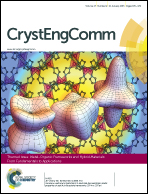Isoreticular isomerism in 4,4-connected paddle-wheel metal–organic frameworks: structural prediction by the reverse topological approach†
Abstract
The theoretical structure prediction for a series of 4,4-connected copper paddle-wheel metal–organic frameworks has been performed by using the reverse topological approach, starting from the nbo-b topology. Since the rectangular-shaped tetracarboxylate linkers have a lower symmetry than the square vertices in nbo-b, two alternative insertion modes are possible for each linker. This leads, in principle, to the formation of multiple isoreticular isomers, which have been screened by a genetic global minimum search algorithm, using the first principles parameterized force field MOF-FF for structure optimization and ranking. It is found that isoreticular isomerism does, in this case, not lead to disorder but to a number of well-defined but structurally distinct phases, which all share the same network topology but have substantially different pore shapes and properties. In all cases, the experimentally observed structure is correctly predicted, but in addition a number of other slightly less stable phases are observed. Only one of these phases has been synthesized yet. The theoretical analysis of the molecular model systems of the pore cages revealed the reasons for the trends in conformational energy. This proof-of-concept study demonstrates that screening of isoreticular isomerism using an efficient but accurate force field allows prediction of the atomistic structure of even complex and flexible frameworks.

- This article is part of the themed collection: Metal-Organic Frameworks and Hybrid Materials

 Please wait while we load your content...
Please wait while we load your content...